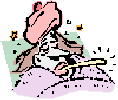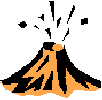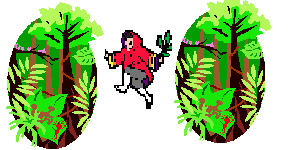
foreword | Historical Narratives | Resources | Links | Contact
HOMESPUN REMEDY
History is a pattern of timeless moments.
Winter weather means colds and influenza which are widely spread by coughs and sneezes. Both are more common in the cold weather because people are often confined to warm, humid places where viruses are more likely to lurk in greater numbers. While there is no remedy for a cold, the flu can now be prevented by vaccines. There were no such remedies two hundred years ago, when residents of the province were afflicted with a variety of diseases most of which also occurred during the winter. Lieutenant Governor John Graves Simcoe was concerned about the frequent outbreaks of illness in the settlements, which laid low large segments of the population, so he turned for the cause and a cure to his physician friend, John Mervin Nooth.
 |
Dr. Nooth was a well-known medical man who was superintendent general of hospitals in Quebec, and personal physician of Lord Dorchester, the Duke of Kent and the Simcoes. Prior to leaving England in 1774, Nooth had been elected to the Royal Society of London, having been nominated for admission to that august group by none other than Benjamin Franklin. As well as being a doctor of note, Nooth was an army officer, a scientist and an inventor. He developed an apparatus to infuse water with "fixed air," the 18th century term for carbon dioxide, and he invented a device for giving artificial respiration. Nooth, who was a keen student of plants and meteorology, was said to have identified variations in the position of the magnetic pole. He also refined maple sugar so that it became as white as West Indian sugar.
 |
On the 23rd of December, 1791 a great light appeared in the sky northeast of Quebec city. Dr. Nooth surmised it was likely caused by the eruption of a volcano, which in turn had resulted from the earthquake that had been "severely" felt a few days before. Mrs. Simcoe wryly noted in her diary that there was a good deal of conjecture over Nooth's notion that a volcano had been caused by an earthquake. She for one was quite skeptical of the good doctor's diagnosis.
 |
Nooth responded to Simcoe's queries regarding widespread sickness in the community and set forth his "sentiments" in a long letter dated January 21st, 1795. Simcoe had suggested to Nooth that the various winter illnesses might have arisen from the woods and forests that surrounded the settlements. J. Mervin Nooth quickly disabused Simcoe of this notion, indicating that on the contrary, woods in general were by no means unhealthy.
In support of his opinion, Nooth cited "recent, decisive experiments" which proved beyond a shadow of a doubt, that air proceeding from "vegetables" in a perfect state of health and vigour was conducive to the good health of man. There was, Nooth noted, no better example of this than the general well-being of the Native peoples. Surveyors after lengthy sojourns in the forest were also found to be robust and healthy in appearance, as were soldiers who returned in high health and good spirits from long residency in the woods. It was unnecessary to elaborate further for both theory and practice convinced Nooth there was nothing noxious in the woods. In other words, the forests made one feel good.
 |
The sicknesses, declared the good doctor, must arise from circumstances attending the settlement itself. In the absence of any obvious sources such as bad air from swamps, Nooth suspected the culprit was the quantity of dead and decaying vegetable matter that everywhere surrounded the settlers. For the comfort and convenience of man, settlements required the woods to be cleared and this necessitated the destruction of trees. How this was done determined the health of the settlements. The most common method of killing trees left the greater part of them to decay gradually. The "exhalations from these dead and dying vegetables" diminished the cleanness of the atmosphere by cutting off pure air and substituting impure air, thus affecting the health of the settlers. Nooth declared dramatically,
In His Own Words"I venture to pronounce this the principal cause of unhealthy conditions."
Nooth suggested that sickness could be prevented by the total destruction of all the trees thought necessary to remove, and in so doing one effectively cleanse the land of dead and decaying vegetables. He recommended that trees including their roots be removed by burning them on the spot. While he acknowledged that initially this might appear costly and time-consuming he was convinced it could be done with relative ease. Using ropes and pulleys properly applied almost all trees could be removed expeditiously by the roots.
In fact, a neighbour of Nooth's in Quebec was doing it with wonderful ease. The ground was thus immediately rendered fit for the plough and dead vegetables were completely eliminated. By taking advantage of mechanical power, woodsmen could eradicate the most stubborn and tenacious of this "vegetable tribe." He promised that salutary effects could be reasonably expected from this plan along with the availability for new settlers of more speedily supplied provisions from the highly productive soil. The doctor concluded by hoping Simcoe's sentiments coincided with his own. He also apologized to His Excellency for the length of his letter, explaining that it was his wish to be useful "that made me tedious."
It would be interesting to know what Simcoe's opinion of Dr. Nooth's knowledge was about the 'vegetable tribe' and their 'noxious exhalations.'In 1797 Dr. Nooth became mysteriously ill and returned to London. Shortly after arriving in England, Nooth coughed up a lead bullet which had been lodged in his bronchial tube. The bullet apparently had been in a glass of wine which Nooth had hurriedly swished then swallowed. It had lain in his tube for some time until he hacked it up in a coughing fit. Apparently Dr. Nooth suffered no ill effects from the slug he had slurped, for he died thirty-one years later at Bath, England on May 3rd, 1828 at the ripe old age of 91.
Copyright © 2013 Website Administrator